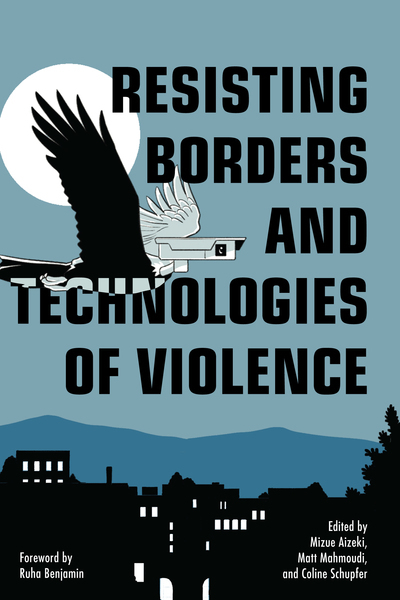“Horrible.” “Shocking.” “Heartbreaking.” So were some of the reactions to photographs and videos showing U.S. Border Patrol corralling Haitian migrants attempting to cross the Rio Grande into the United States in September 2021. The agents straddled horses, wielding whips and shouting expletives in scenes that seemed to evoke a prior era of racial slavery. Social media erupted with charges of racism at the routine dehumanization of Black, Latinx, and Indigenous migrants, a stark contrast to the border crossers coming into the country from Canada, or those entering the country by plane, including the recent arrival of Ukrainian refugees.
“One group is being met with food, cheers, places to live, etc.—which is what welcoming looks like. And the other group is being met with cowboys with leather straps or ropes and detention by force,” said Nana Gyamfi, the daughter of Ghanaian immigrants and executive director of Black Alliance for Just Immigration (BAJI).

On Instagram, I scrolled past vintage drawings of slave catchers in the 1800s juxtaposed with this recent footage of U.S. Border Patrol agents hovering over the drenched bodies of families carrying their belongings in trash bags. Scrolling further, I saw a friend’s post of a video of Joe Biden in a 1994 PBS interview with Charlie Rose, saying, “If Haiti just quietly sunk into the Caribbean or rose 300 feet into the air, it wouldn’t matter a whole lot in terms of our interests.” Another friend posted the words of poet Warsan Shire, “You have to understand, no one puts their children in a boat unless the water is safer than the land,” floating above the image of a girl clinging to her father as he waded through the water.
The Biden administration knows the land is unsafe for those in Haiti. It acknowledged the dire conditions in the country earlier in the year when the administration announced that Haitians already living in the United States were eligible for Temporary Protected Status. But new arrivals seeking asylum need not apply. Instead, the administration proceeded to expel migrants crossing from Mexico, many of whom had been residing in South America since the 2010 earthquake in Haiti, deporting them to a country experiencing political violence and ongoing humanitarian disasters.
“The US government showed a total disregard for the right to seek asylum when it sent agents on horseback with reins flailing to control and deter this largely Black migrant population,” said Alison Parker, U.S. managing director at Human Rights Watch. “This violent treatment of Haitians at the border is just the latest example of racially discriminatory, abusive, and illegal US border policies that are returning people to harm and humanitarian disaster.”
But it is not simply border agents on horseback that make the scene violent—it’s borders, period. The political construction of borders perpetuates global inequalities and routinizes state-sanctioned murder. It does so both by limiting people’s mobility and by punishing those who actively challenge the border regime. As political geographer Reece Jones writes in Violent Borders: “By refusing to abide by a wall, map, property line, border, identity document, or legal regime, mobile people upset the state’s schemes of exclusion, control, and violence. They do this simply by moving.” And in upsetting the state, mobile people become targets for repression.
More from our decarceral brainstorm
Every week, Inquest aims to bring you insights from people thinking through and working for a world without mass incarceration.
Sign up for our newsletter for the latest.
Newsletter
The violence visited upon people of Haitian descent in the U.S.–Mexico borderlands in September 2021 is only one manifestation of such repression. This high-profile spectacle of border violence against Haitian migrants captured widespread attention, perhaps because it falls on the most obvious end of a carceral continuum that seeks to contain racialized populations in the name of public safety and public health. But what of the more insidious end of the spectrum—the end that appears nonviolent, but effectively does most, if not all, the same work as the overtly violent?
A November 2020 report prepared for the United Nations General Assembly by special rapporteur E. Tendayi Achiume notes that many of the emerging digital technologies employed in immigration and border policing have “historical antecedents in colonial technologies of racialized governance.” This speaks to how “not only is technology not neutral, but its design and use typically reinforce dominant social, political and economic trends.” Indeed, the report finds that national governments employ these technologies in ways that “advance the xenophobic and racially discriminatory ideologies which have proliferated in part due to widespread perceptions of refugees and migrants as per se threats to national security.”
It is also a manifestation of what I call “the New Jim Code”: the employment of technologies that reflect and reproduce existing inequities but that are promoted and perceived as more objective or progressive than the discriminatory systems of a previous era. A 2015 audit of California’s gang database reveals a very different reality. The audit found that Black and Latinx individuals constituted 86 percent of those listed. Some of the names even turned out to be babies under the age of one, entered as supposedly “admitting to being gang members.” So far, no one has explained how this could have happened, except by saying that some combination of zip codes and racially coded names constitutes a risk.
Such outcomes raise serious questions about what it means to deploy supposedly neutral technologies in a context that embodies an unjust set of social relations. Innocence and criminality are not objective states of being that an algorithm can detect, but are created through the interaction between technology and a deeply racialized history, in which a certain type of person is coded as a criminal. Once someone is added to the database, whether they know they are listed or not, they undergo even more surveillance and lose a number of rights.
Inclusion in this context is more akin to possession, as in the conceit in Frantz Fanon’s plea that the “tool never possess the man,” where possession alerts us to the way that freedom is constrained. The goal is thus not simply to tweak the technology to make it “less biased.” Designing surveillance technologies to be less biased simply enables them to better carry out the racially discriminatory violence mandated by an already racist, white supremacist, xenophobic state. The goal must instead be to address the sociopolitical and economic conditions that give rise to injustice and surveillance in the first place.
The task, then, is to connect obvious forms of harm and discrimination with more insidious technologies—immigrant databases, digital IDs, and electronic tracking systems, to name a few. For all the talk of “smart” borders, which use the latest in facial recognition, aerial drones, and data fusion centers, borders are just becoming more sophisticated sites of racialized surveillance, displacement, and death. Here we must understand “smartness” as the ability to more “efficiently” categorize and distinguish desirables from undesirables, rich from poor, expat from migrant and refugee, and capital from labor. In this sense, these advancements scale colonial efforts of times past to enclose and condemn communities to a life of performing free labor and generating value or capital.
Today, these technologies are used to determine everything from who gets to access safe harbor in a new country, welfare services, and shelter, to who is booked for or released from prison, and who is targeted and persecuted for exercising their right to protest. The eugenicist underpinnings of both artificial and organic intelligence and its primary directive—to categorize and rank humans—are, in other words, inescapable.
The power of the New Jim Code is that it allows racist habits and logics to enter through the back door of tech design, whereby the humans who create the algorithms are hidden from view. We need abolitionist tools that counter tech-mediated forms of violence (e.g., anti-Blackness in the United States) and that help us put an end to the policies and technologies that governments and companies are deploying quietly and viciously, technologies that tear into people’s lives, rip families apart, and hunt down the most vulnerable, one computer bit at a time.
Excerpted from Resisting Borders and Technologies of Violence. Copyright © 2024 by Mizue Aizeki, Matt Mahmoudi, and Coline Schupfer; foreword by Ruha Benjamin. Reprinted with permission from Haymarket Books.
Image: Barbara Zandoval/Unsplash

